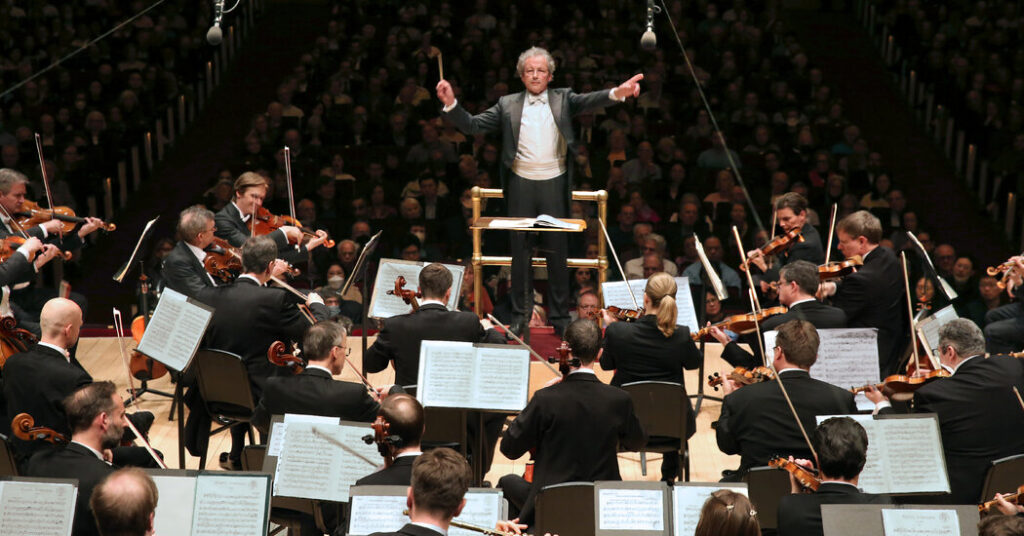Vienna Philharmonic and Franz Welser-Möst Return to Carnegie

The Vienna Philharmonic hasn’t had a chief conductor since 1933. But it has had favorite conductors.
Of the great musicians who have led this self-governing, proudly idiosyncratic orchestra, Leonard Bernstein and Pierre Boulez were made honorary members; Herbert von Karajan and Karl Böhm were given honorary conducting titles. The violinist Daniel Froschauer, the Philharmonic’s chairman, has said that today, the ensemble not so secretly has two maestros at the top of its roster: Riccardo Muti and Franz Welser-Möst.
At Carnegie Hall last weekend, it was the Austrian-born Welser-Möst, 63, who conducted three breathless, exhilarating and often moving performances by the Philharmonic, in meaty programs of Bruckner and Mahler symphonies, and works by Berg, Hindemith, Schoenberg, Strauss and Ravel.
It takes a lot to win over the affection of the Philharmonic, one of Europe’s finest ensembles, just as it takes a lot to join its ranks. These players — known for their lush sound, their brighter, higher tuning frequency and their distinctly Viennese articulation — can be haughty and stubborn; I have seen them outright defy a conductor in rehearsal.
Welser-Möst has not only penetrated the Philharmonic’s inner circle, but also has done so while leading the Cleveland Orchestra — another top-notch ensemble, though one whose sound differs enormously from that of the Viennese.
The main difference between the Cleveland Orchestra and the Vienna Philharmonic is that while the Clevelanders have been criticized for giving performances that are too good, no one could ever accuse the Viennese of the same.
In Cleveland, Welser-Möst has for the past two decades maintained and deepened the orchestra’s transparent, clean sound. (He will leave his post in 2027.) Its playing is the most precise of any American ensemble, impeccably balanced to the delight of perfectionists and the frustration of those who crave more daring in their concerts.
The Philharmonic is also impressively skilled, but with a touch of messiness that tends to enliven rather than diminish a score. These players are, above all, human: Expressivity pervades their wide tremolos, wailing glissandos and physical gestures that verge on theatrical.
If the Clevelanders like their music lean, the Viennese like it fatty, “mit Schlag.” Together, these orchestras embody two approaches to musical excellence. And able to walk either path with them is Welser-Möst.
At Carnegie, the Philharmonic’s style was at its most pronounced in Bruckner and Mahler’s ninth symphonies — which were fitting inclusions in Welser-Möst’s Perspectives series at the hall, but not in its festival “Fall of the Weimar Republic: Dancing on the Precipice.”
The Weimar Republic, during its short life from 1918 to 1933, was an extraordinary period for all types of art. Audience members at the Philharmonic concerts, though, could barely glean that from its three programs, which only glanced at the era and grasped at thematic relevance. The performances more richly represented the Germanic world inching into modernism on the cusp of World War I, and the disillusioned mood of the war’s aftermath: the decline of Romanticism and the rise of embittered irony.
That idea can overlap with, but is not the same as, the precarity and collapse of the Weimar Republic. And where they met was the Philharmonic’s Saturday program, which opened with Hindemith’s Konzertmusik für Blasorchester, written in 1926 for a military band with the kind of satirical spirit you could hear on the revue stages of Berlin at the time. It was there that Schoenberg’s Variations for Orchestra premiered in 1928, disastrously mishandled by the Berlin Philharmonic under Wilhelm Furtwängler. But at Carnegie both received easily legible readings; the Schoenberg, played with a comfort that let its underlying expressiveness come through, provided proof that “atonal” doesn’t inherently mean “unpleasant.”
From there, the Philharmonic’s programming trailed away from the Weimar Republic, with works like Ravel’s “La Valse,” first performed not in Germany but in the Paris of 1920; and Strauss’s Symphonic Fantasy from “Die Frau Ohne Schatten,” a 1947 reworking of an opera written before and during World War I.
Which is not to discount the performances of these pieces. The Ravel unfurled like a dreamy memory of the Philharmonic’s famous New Year’s concerts — one that gives way to a nightmare. And the Strauss, difficult to balance with its large scale and dense writing, was an alluringly perfumed stroll through the luxuriant sound world of “Frau.”
Furthest, perhaps, from the Weimar theme was the Bruckner, dedicated to God and left incomplete at the composer’s death in 1896. Welser-Möst likes to play with juxtaposition, and on Friday, he paired it, as something of a finale, with Berg’s Three Pieces for Orchestra, written in the 1910s — Berg’s music bringing Bruckner’s across the threshold of modernity.
Bruckner’s Ninth, discursive and inconclusive, at one point rivaling the mystery and mystical power of Wagner’s “Parsifal,” acquired dramatic shape and cohesion under Welser-Möst. Its introduction began quietly until it escalated to an explosive declaration, and the passages that followed rose and fell like a distress signal, flaring brightly and fading. From silences emerged wisps of melody and balletic delicacy, before more eruptions that left behind softly glowing halos of sound.
There was a similar sense of shape — a wrangling of immensity — in Mahler’s Ninth Symphony, which stood alone on Sunday. Welser-Möst took a brisk tempo, but with vitality rather than impatience, making for a running time of about 75 minutes where some conductors stretch the score to more than 90.
This is a work full of farewells: an allusion to Beethoven’s “Les Adieux” sonata, inscriptions by Mahler of “Leb’ wohl!” and an ending that quietly takes leave while, as Theodor Adorno wrote, looking questioningly into uncertainty.
Welser-Möst’s interpretation was one with much to say on the way out. The first movement developed with defiant freedom before giving way, in later movements, to a ländler, a folk dance particularly popular in Austria, that began with rustic earthiness but ended with a cosmic dance, and, by the finale, a passionate elegy.
That last movement is often performed as a kind of prolonged death. But the direction “ersterbend,” or “dying,” doesn’t appear in the score until the penultimate page, and the Philharmonic players didn’t take a linear journey to arrive there, with swerves of energy from passages of glacial tranquillity. The music wasn’t ready to say goodbye, and after three days, neither were they.





